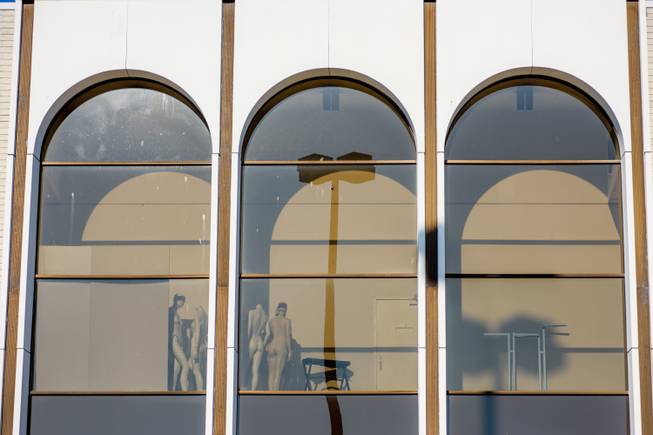
Matt Roth / The New York Times
Mannequins stand in the Lord & Taylor department store, the sole retailer remaining at the otherwise sealed-off White Flint Mall in Bethesda, Md. High-end shopping malls are thriving across the country, but as mid-tier retailers such as Sears and J.C. Penney flounder, they are also dragging down their malls.
Sunday, Jan. 11, 2015 | 2 a.m.
OWINGS MILLS, Md. — Inside the gleaming mall here on the Sunday before Christmas, just one ingredient was missing: shoppers.
The upbeat music of “Jingle Bell Rock” bounced off the tiles and the smell of teriyaki chicken drifted from the food court, but only a handful of stores were open at the sprawling enclosed shopping center. A few visitors walked down the long hallways and peered through locked metal gates into vacant spaces once home to retailers like H&M, Wet Seal and Kay Jewelers.
“It’s depressing,” Jill Kalata, 46, said as she tried on a few of the last sneakers for sale at the Athlete’s Foot, scheduled to close in a few weeks. “This place used to be packed. And Christmas, the lines were out the door. Now I’m surprised anything is still open.”
The Owings Mills Mall is poised to join a growing number of what real estate professionals, architects, urban planners and Internet enthusiasts term “dead malls.” Since 2010, more than two dozen enclosed shopping malls have been closed, and an additional 60 are on the brink, according to Green Street Advisors, which tracks the mall industry.
Premature obituaries for the shopping mall have been appearing since the late 1990s, but the reality today is more nuanced, reflecting broader trends remaking the U.S. economy. With income inequality continuing to widen, high-end malls are thriving, even as stolid retail chains like Sears, Kmart and J.C. Penney falter, taking the middle- and working-class malls they anchored with them.
“It is very much a haves and have-nots situation,” said D.J. Busch, a senior analyst at Green Street. Affluent Americans “will keep going to Short Hills Mall in New Jersey or other properties aimed at the top 5 or 10 percent of consumers. But there’s been very little income growth in the belly of the economy.”
In Las Vegas, for instance, the Boulevard mall is far from dead but a long way from its heyday.
Two miles east of the Strip, Boulevard opened in the 1960s and drew huge crowds through the ’70s. It was one of Las Vegas’ top shopping spots, turning Maryland Parkway into the valley’s premier retail corridor. But the mall eventually lost its standing with shoppers, who fled for fast-growing suburbs and Fashion Show mall on the Strip. In recent years, the property had financial woes as retailers packed up and left, and many locals dismissed Boulevard as dated and run down.
Developer Roland Sansone, however, is betting big money that Boulevard can be widely popular again.
He bought the mall in November 2013 for $54.5 million from lenders who listed it at a price of “best offer.” Sansone then launched a planned $25 million overhaul.
Glut of stores blamed
At Owings Mills, J.C. Penney and Macy’s are hanging on, but other midtier emporiums such as Sears, Lord & Taylor and the regional department store chain Boscov’s have all come and gone as anchors.
Having opened in 1986 with a renovation in 1998, Owings Mills is young for a dying mall. And while its locale may have contributed to its demise, other forces, like changing shopping habits and demographics, played a crucial role, too, experts say.
“I have no doubt some malls will survive, but major segments of our society have gotten sick of them,” said Mark Hinshaw, a Seattle architect, urban planner and author.
One factor many shoppers blame for the decline of malls — online shopping — is having only a small effect, experts say. Less than 10 percent of retail sales take place online, and those sales tend to hit big-box stores harder, rather than the fashion chains and other specialty retailers in enclosed malls.
Instead, the fundamental problem for malls is a glut of stores in many parts of the country, the result of a long boom in building retail space of all kinds.
“We are extremely over-retailed,” said Christopher Zahas, a real estate economist and urban planner in Portland, Ore. “Filling a million square feet is a tall order.”
About 80 percent of the country’s 1,200 malls are considered healthy, reporting vacancy rates of 10 percent or less. But that compares with 94 percent in 2006, according to CoStar Group, a leading provider of data for the real estate industry.
Nearly 15 percent are 10 to 40 percent vacant, up from 5 percent in 2006. And 3.4 percent — representing more than 30 million square feet — are more than 40 percent empty, a threshold that signals the beginning of what Busch of Green Street calls “the death spiral.”
Industry executives freely admit the mall business has undergone a profound bifurcation since the recession.
“You see the A-rated malls, the flagship malls, performing very well,” said Steven Lowy, co-chief executive of Westfield Corp., which has its roots in Australia but is now a major global player among mall owners. “Our business is more regional and high-end focused. There are gradients of dead or dying or flat, but anything that’s caught in the middle of the market is problematic.”
Tom Simmons, who oversees the mid-Atlantic shopping center division of Kimco, another real estate giant, is more blunt.
“There are B and C malls in tertiary markets that are dinosaurs and will likely die,” he said, but “A malls are doing well.”
Sun reporter Eli Segall contributed to this report.

Join the Discussion:
Check this out for a full explanation of our conversion to the LiveFyre commenting system and instructions on how to sign up for an account.
Full comments policy